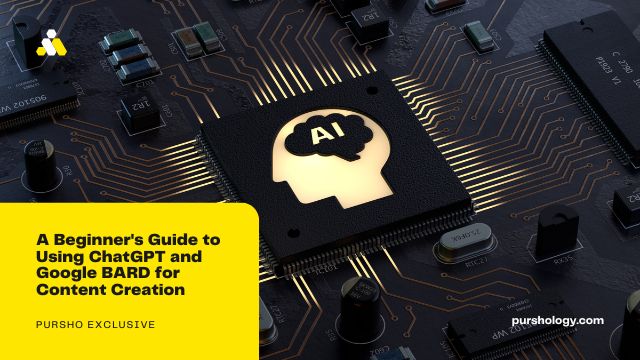Introduction: Why ChatGPT and Google BARD are Worth Exploring
As the demand for quality content continues to rise, content creators are turning to artificial intelligence (AI) writing tools like ChatGPT and Google BARD to streamline their writing process. These tools use natural language processing (NLP) and machine learning algorithms to generate high-quality content in seconds, saving writers time and effort.
With ChatGPT, users can input prompts and receive coherent responses that match the context of their writing. Google BARD offers a similar service, but with a focus on creative writing. By using AI writing tools like ChatGPT and Google BARD, content creators can increase their output and maintain consistent quality across all their written material.
This beginner’s guide will provide an overview of how these tools work and how they can be leveraged for various content creation needs.
What are ChatGPT and Google BARD?
ChatGPT and Google BARD are AI-powered writing tools that use natural language processing and machine learning to generate high-quality content quickly and efficiently. ChatGPT, developed by OpenAI, is a language model that can produce text based on user prompts.
It is designed to respond to specific prompts in a conversational style, making it useful for content creation needs such as chatbots, email marketing, and social media posts. Google BARD, on the other hand, is a language model that specializes in creative writing, such as poetry, fiction, and song lyrics. On the other hand ChatGPT & Google Bard also plays an eseetial role in software companies.
It uses a deep learning algorithm to generate text that matches the style and structure of the input text. Together, these tools offer content creators a powerful way to generate quality content in less time.
Getting Started with ChatGPT and Google BARD
Getting started with ChatGPT and Google BARD is relatively straightforward. First, users need to visit the respective websites and select the desired tool. For ChatGPT, users can simply enter their prompt and the tool will generate a response.
For Google BARD, users can input a phrase or sentence and the tool will generate creative writing based on the input. It is important to note that these tools rely on pre-trained models and may require fine-tuning to produce the desired output.
Additionally, users should be mindful of the limitations of these tools and supplement generated content with their own input. With some experimentation and practice, users can become proficient in using ChatGPT and Google BARD for their content creation needs.
Using ChatGPT and Google BARD for Blog Posts
Blog posts are a popular type of content that can benefit greatly from using ChatGPT and Google BARD. These tools can generate ideas for blog posts, suggest headlines, and even generate entire articles. With ChatGPT, users can input a keyword or topic and the tool will generate content based on the input.
Google BARD can be used to generate creative writing based on a specific topic or prompt, which can be used to spark inspiration for blog posts. However, it is important to note that these tools may require fine-tuning to produce high-quality content.
Additionally, users should ensure that the generated content is optimized for SEO and readability before publishing.
Using ChatGPT and Google BARD for Social Media Posts
ChatGPT and Google BARD can be useful for generating social media posts that engage followers and promote brand awareness. With ChatGPT, users can input prompts such as questions or statements and receive responses in a conversational style. This can be helpful for generating captions, replies to comments, and even entire social media posts.
Google BARD can be used to generate creative writing based on a specific theme or topic, which can be used as content for social media posts. Additionally, ChatGPT and Google BARD can help users stay up-to-date with current trends and topics by generating content related to popular hashtags or news events.
However, it is important to ensure that the generated content is on-brand, appropriate for the platform, and optimized for engagement. Users should also be aware that AI-generated content may not always be perfect and may require editing before posting.
Using ChatGPT and Google BARD for Email Marketing
ChatGPT and Google BARD can be valuable tools for email marketing. ChatGPT’s natural language processing capabilities allow it to generate personalized and engaging email content that resonates with individual recipients. It;s also an crucial part of digital marketing companies.
BARD, on the other hand, provides valuable insights into customer behavior, allowing email marketers to create targeted campaigns that are more likely to drive conversions.
By combining the two tools, email marketers can craft highly effective campaigns that deliver personalized, relevant messages to each recipient. With ChatGPT and BARD, businesses can optimize their email marketing efforts and improve their overall return on investment.
Using ChatGPT and Google BARD for Product Descriptions
ChatGPT and Google BARD can be powerful tools for creating compelling product descriptions. ChatGPT’s natural language generation abilities allow it to craft product descriptions that are engaging and informative, while BARD provides valuable insights into customer behavior and preferences.
By leveraging these tools, businesses can create product descriptions that resonate with their target audience and drive conversions.
ChatGPT can help businesses create descriptions that are more personalized, while BARD can provide data-driven insights into what customers are looking for in a product.
Together, these tools can help businesses optimize their product descriptions and increase sales by appealing to the needs and preferences of their target audience.
Tips for Working with ChatGPT and Google BARD
When working with ChatGPT and Google BARD, there are several tips that can help businesses maximize the effectiveness of these tools.
Firstly, it’s important to ensure that the input data fed into these tools is clean and relevant. ChatGPT and BARD rely heavily on data, so it’s essential to ensure that the data is accurate and up to date. Now a days these tools are also an essential components of digital marketing agencies.
Secondly, it’s important to have a clear understanding of the business goals and target audience. This helps to ensure that the output generated by ChatGPT and BARD is relevant and actionable.
Thirdly, it’s important to continually monitor and analyze the results generated by ChatGPT and BARD. This helps to identify areas for improvement and to optimize the use of these tools.
Finally, it’s important to have a good understanding of the limitations of these tools. While ChatGPT and BARD are powerful tools, they are not infallible and may require human intervention to ensure the output is accurate and relevant.
By following these tips, businesses can effectively work with ChatGPT and Google BARD to generate high-quality content and gain valuable insights into customer behavior.
Limitations of ChatGPT and Google BARD
While ChatGPT and Google BARD are powerful tools, they do have certain limitations. One limitation of ChatGPT is that it can sometimes generate irrelevant or inaccurate output if the input data is not properly curated.
Additionally, ChatGPT may struggle with understanding and generating content for highly technical or specialized topics. On the other hand, Google BARD relies heavily on data and may not be effective if the data input is incomplete or inaccurate. Furthermore, BARD may not account for certain external factors that may influence customer behavior, such as economic trends or cultural factors.
Despite these limitations, both ChatGPT and BARD can be highly effective tools when used properly and in conjunction with other data and insights.
Conclusion: How ChatGPT and Google BARD Can Improve Your Content Creation
In conclusion, ChatGPT and Google BARD can be powerful tools for improving content creation. ChatGPT’s natural language generation abilities can help businesses create personalized and engaging content, while BARD’s data-driven insights can help businesses optimize their content for their target audience.
By leveraging these tools, businesses can improve the quality and relevance of their content, leading to increased engagement, conversions, and ultimately, revenue.
However, it’s important to note that these tools are not perfect and should be used in conjunction with human input and analysis to ensure accuracy and relevance.
Overall, ChatGPT and Google BARD can be valuable assets for businesses looking to improve their content creation and drive success in today’s digital landscape.
Author Bio
Kashish Mehta is a Digital Marketing Expert and an Outreach Specialist at Brandveda. She loves to talk about SEO, content marketing & digital marketing strategies. In her free time, she likes to read & stay updated on the latest digital marketing trends!
You can always reach out to kashish on LinkedIn.




